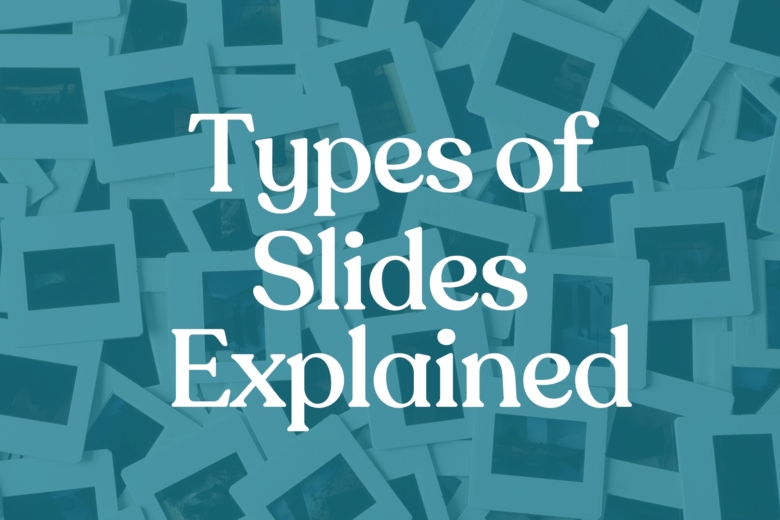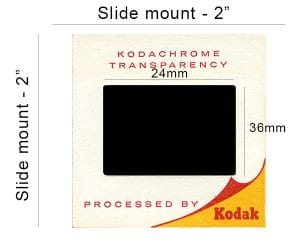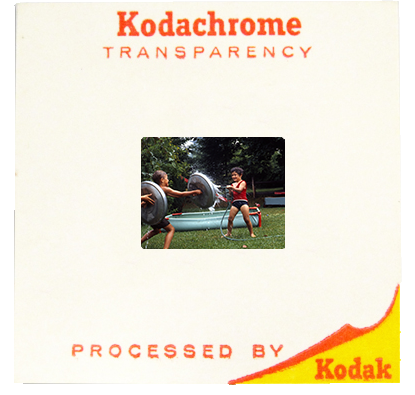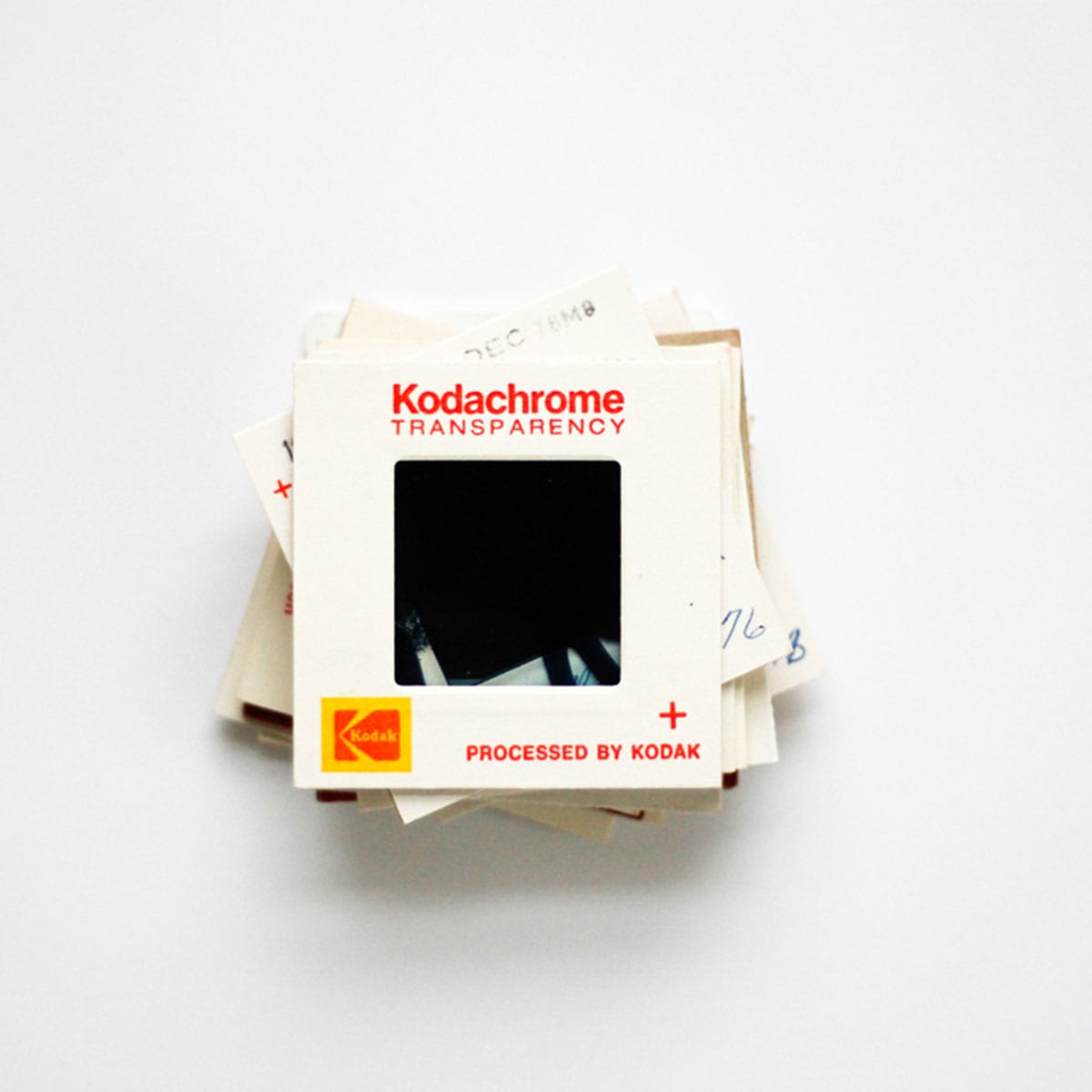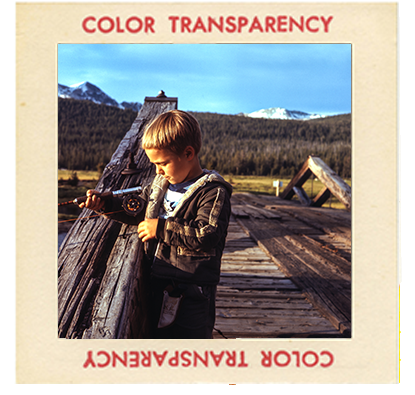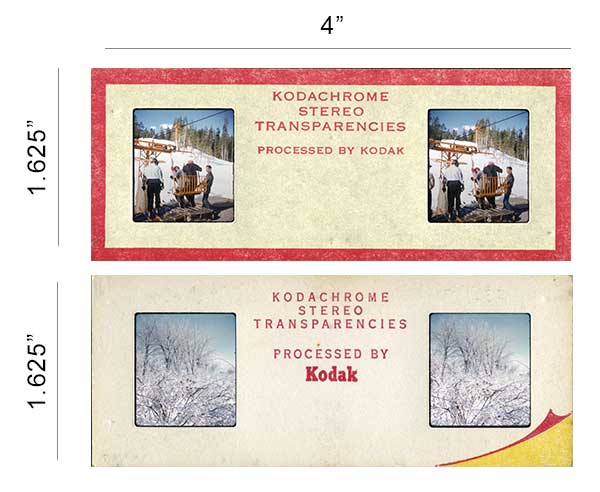If you have a box of old 35mm mounted slides in your attic or on your bookshelf, you’re not alone. These little frames of film were once the go-to way to share photos, from family snaps to professional shoots.
While most slides come in that familiar 2×2-inch mount, there are actually quite a few different types of slides out there. This guide breaks down the most common formats so you can identify what you have and start thinking about the best way to preserve them.
THE DIFFERENT TYPES OF SLIDES EXPLAINED
Thankfully, most slides can be easily identified by size and format, even if you’re not an expert. Here are the most common types you’ll come across.
1. STANDARD 35MM SLIDE
This is the classic format most people think of when picturing a photographic slide. A standard 35mm slide is mounted in a 2×2-inch cardboard frame, with a clear plastic cover protecting the image itself.
These slides are sometimes called ‘photo transparencies’ as you can hold the slide up to a light source and see through the image like a window.
The edge of the slide is typically labelled with the film brand (like Kodak or Fujifilm), and they were very common from the 1950s through the early 2000s. They were often used as projector slides; you may have memories of viewing slide shows projected onto the walls at school or home.
2. HALF-FRAME 35MM SLIDE
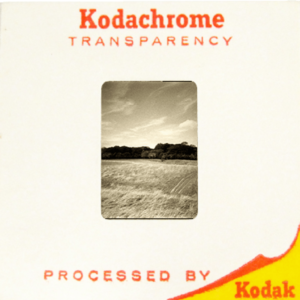
Half-frame 35mm slides are basically what they sound like: images that take up half the space of a standard 35mm frame. The slide mount is still 2×2 inches, but the image will look smaller within it, with more empty space around the edges. Instead of the 24x36mm image window on a standard 35mm slide, you’re looking at something closer to 18x24mm.
Originally designed as a budget-friendly option in the 1960s, they quickly became popular with photographers. They allowed you to shoot twice as many photos per roll of film; 72 exposures in a cartridge instead of just 36.
3. 110 AND MINI 110 SLIDES
Small but mighty, 110 format slides were introduced in the 1970s as a compact, easy-to-use option for casual photographers. They weren’t the best quality, but they were convenient.
A full 110 slide mount is still about 2×2 inches, but the image is only around 13x17mm. The film comes in a pre-loaded cartridge, eliminating the need to manually thread film onto a spool and making it much easier to use. It remains a popular choice for fuss-free, spontaneous photography and amateurs looking to dive into the world of analog photos.
Mini 110 slides have the same size image, cased in a smaller cardboard frame, and were popular in the ‘70s and ‘80s.
4. 120 SLIDES
A much larger image area than the 35mm, 120 slides come from medium format film and were introduced by Kodak in 1901. If you’re holding a slide that’s clearly bigger than standard or doesn’t fit in a typical slide projector, it’s probably from 120 film.
They were favorites of professionals, thanks to their higher quality. The images themselves have incredible detail and rich color because of the larger negative size.
5. 126 SLIDES
126 slides were made for Instamatic cameras, which were hugely popular in the 1960s and 70s. The slide mounts are still 2×2 inches like standard 35mm, but the image area is square and measures 26.5×26.5mm. It’s easy to mistake them for regular slides at first glance, but that square shape is the giveaway.
The image may also look a little softer or grainier, especially compared to 35mm, because of the slightly larger but less precise film format. If the photo in the mount is a perfect square and maybe even labeled “Kodachrome” or “Instamatic,” you probably have a 126 slide.
6. 127 SLIDES AND SUPERSLIDES
These Kodak slides are the middle child between 35mm and 120 film; larger than standard but not as big as a 120 slide. Most 127 slides are square and mounted in 2×2-inch frames, but the image size is usually 40x40mm, so there’s less of a cardboard border.
Superslides are mounted in the same 2×2-inch size but have an even bigger image. If your slide goes nearly all the way to the edge of the mount, it might be a superslide.
7. STEREO SLIDES
A very expensive format to shoot with, stereo slides were the old school way of creating a 3D image. Each mount contains two nearly identical images side by side, usually taken with a special stereo camera that mimicked the spacing of human eyes.
The idea was to view the slides with a stereoscope to get a pop-out effect. Most stereo slides are rectangular (typically around 4×1.75 inches), and the two images are clearly visible. When digitized correctly, they’re still a very impressive medium.
8. LARGE FORMAT SLIDES
These slides are made from large-format film, typically 4×5 inches or even bigger. Unlike the other slides we’ve listed, they’re not usually mounted, though some may be stored in plastic or archival sleeves.
You’ll rarely see these in home collections unless the photographer was a serious pro or artist. The image quality is stunning and perfect for enlargement, but they’re not traditional projector slides.
If you’ve found something that’s closer to a sheet of paper than a tiny slide, it’s large format. Handle with care as they’re valuable and delicate!
NOW THAT YOU KNOW WHAT TYPES OF SLIDES YOU’RE WORKING WITH…
Identifying your slides helps you store them properly, handle them safely, and make the most of the images inside. But no matter what type of slide you have in your collection, all share one thing: they don’t last forever.
Colors fade, film warps, and mounts can crack. If you want to keep those memories alive, the best thing you can do is digitize them. That way, your memories stay safe and easy to share for generations to come.
DIGITIZE YOUR SLIDES WITH EVERPRESENT
Let us do the hard work. EverPresent’s slide scanning service makes it easy to digitize your slides, whether you have just a handful or a whole library of carousels. With over 30 years of experience, we’ve preserved more than 50 million memories thanks to our 80+ expert technicians.

